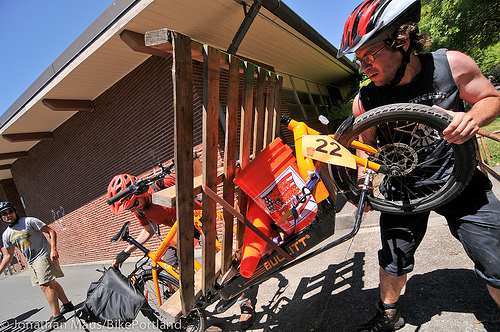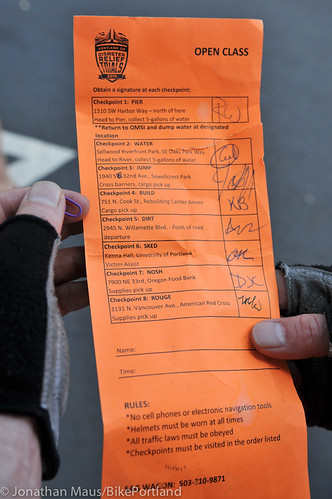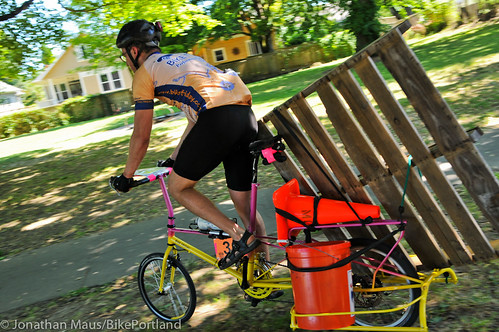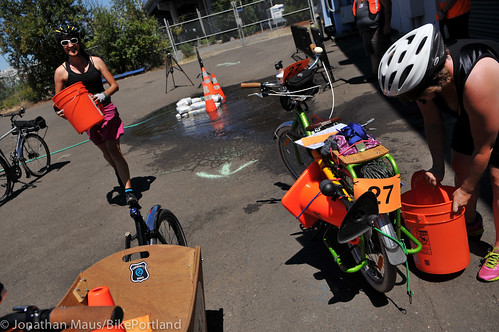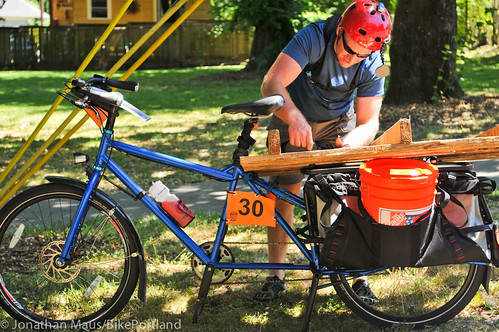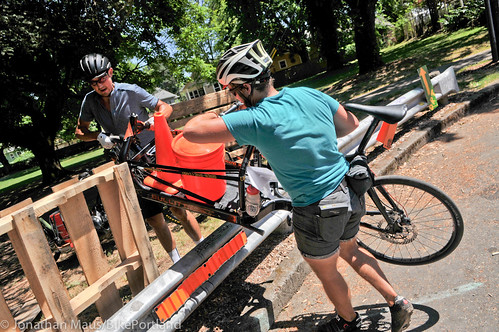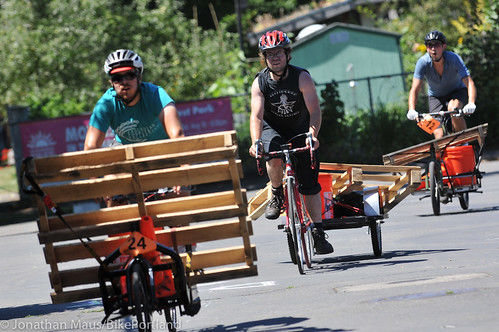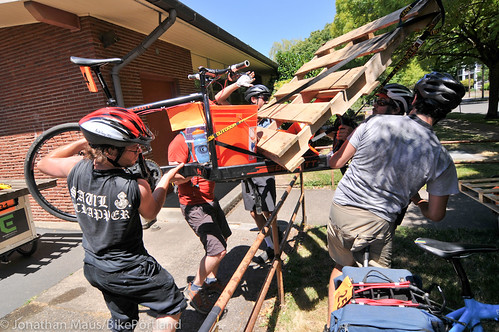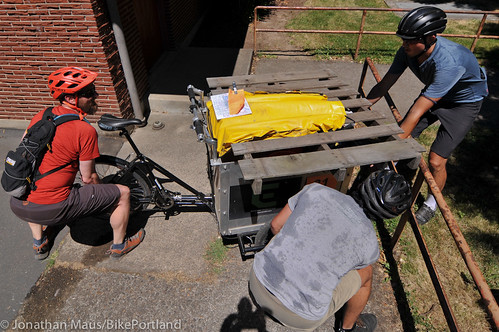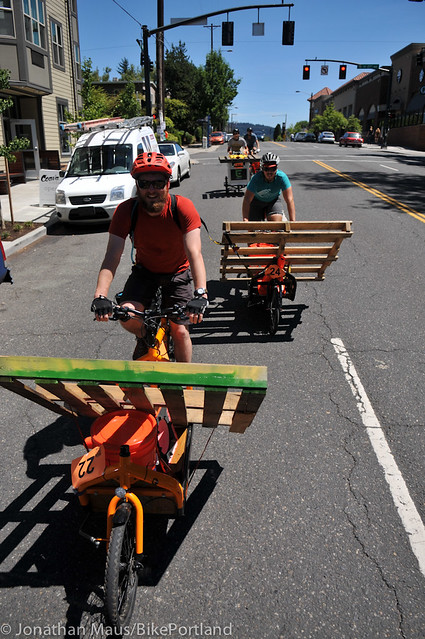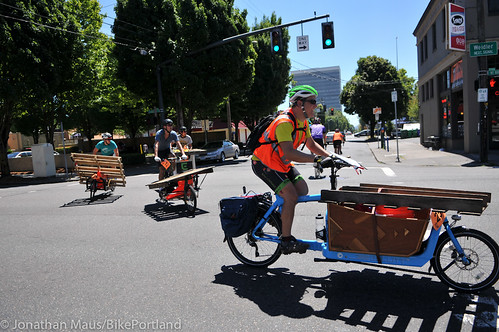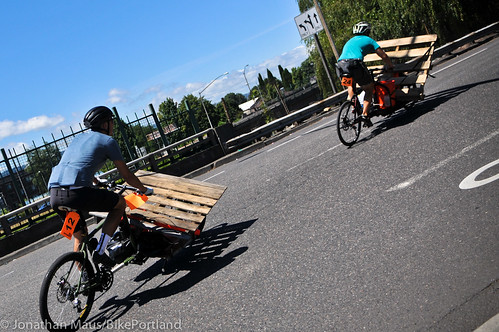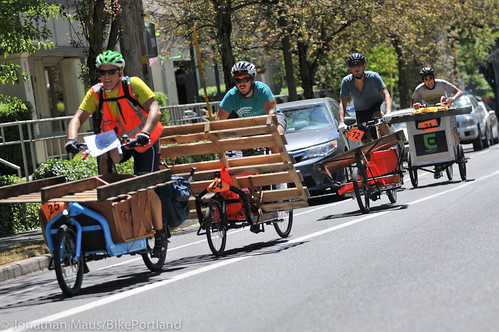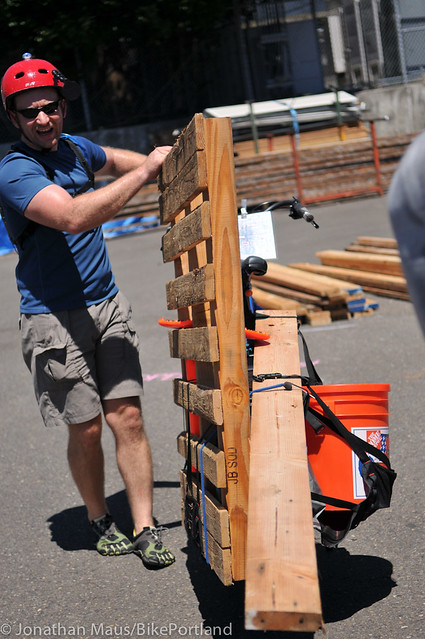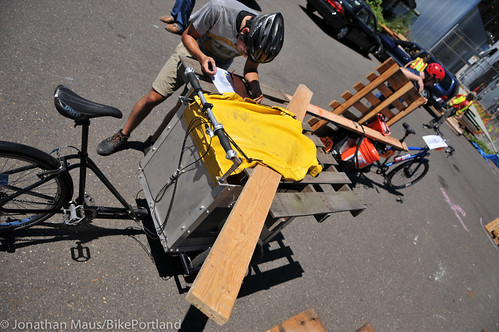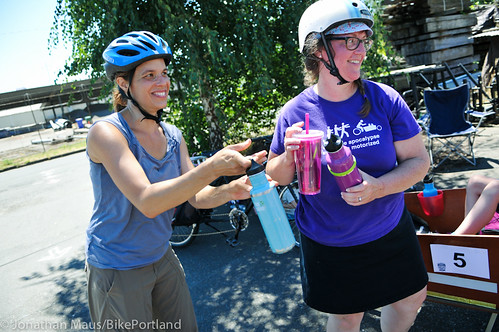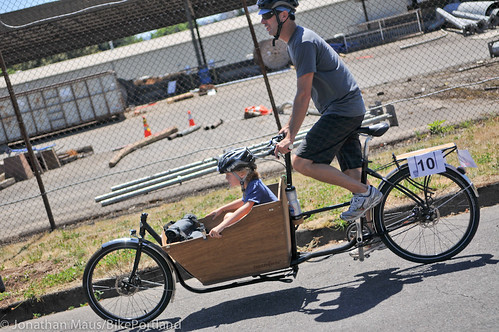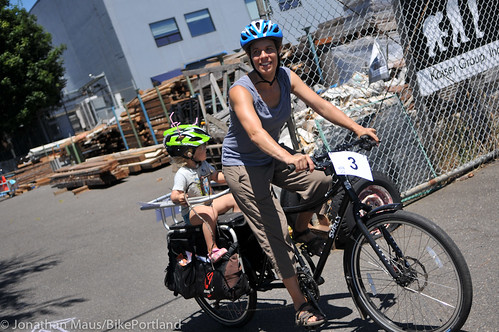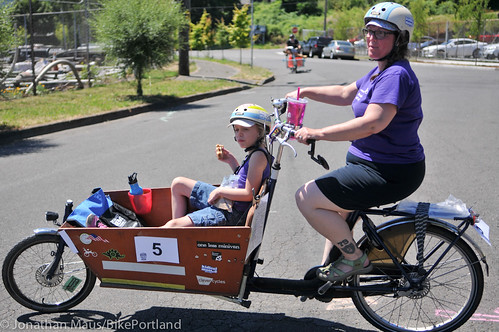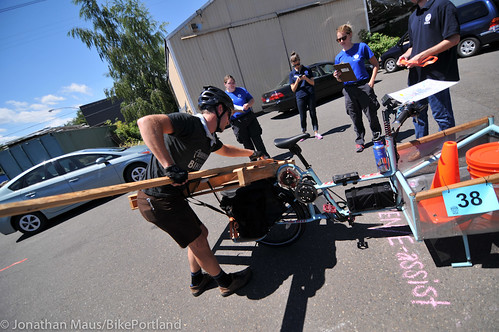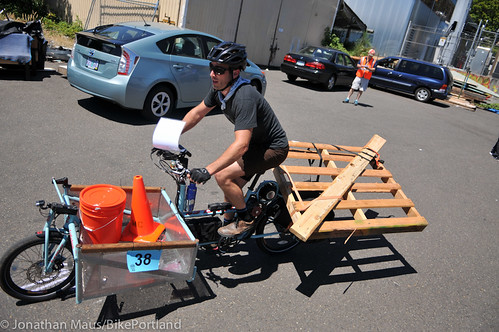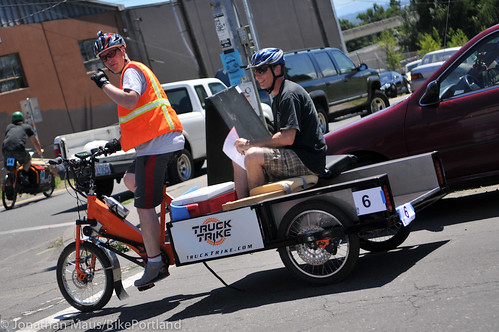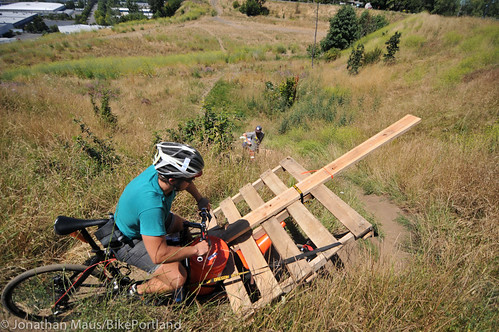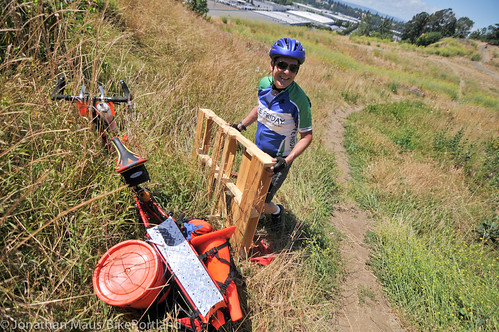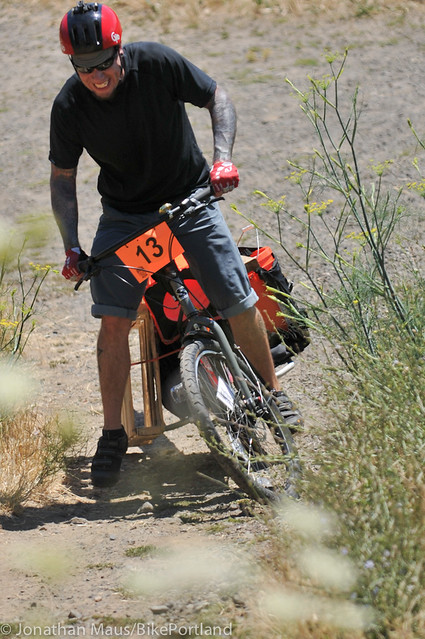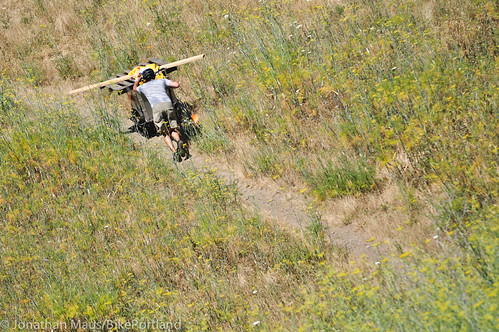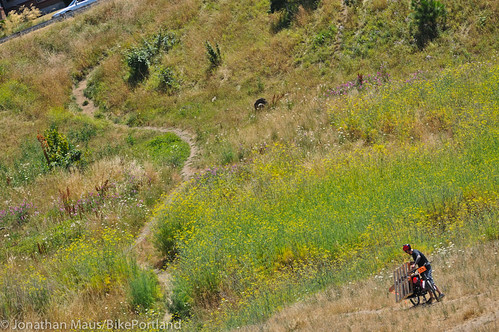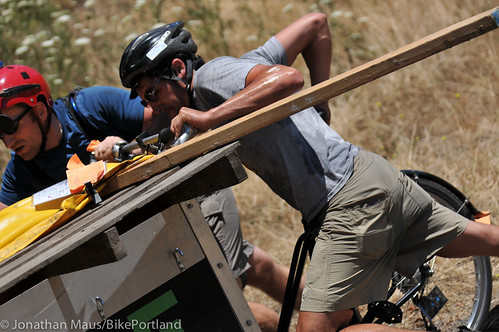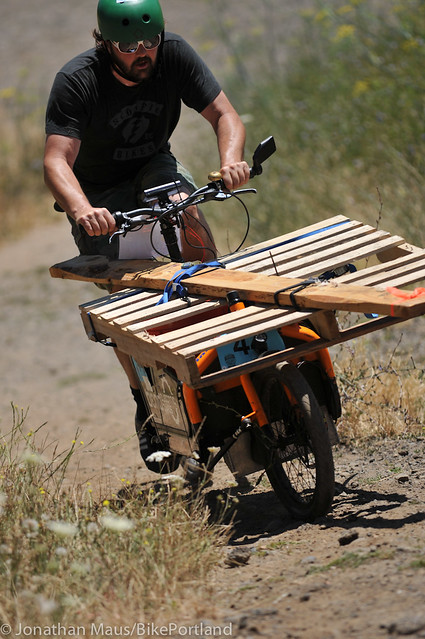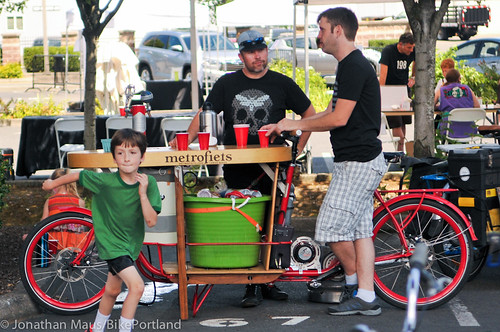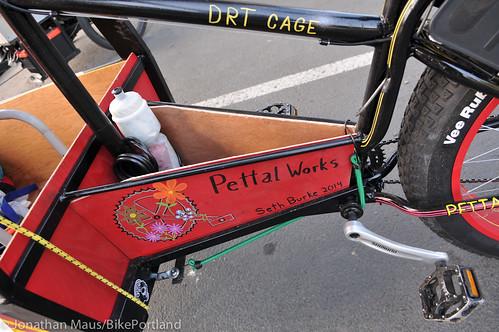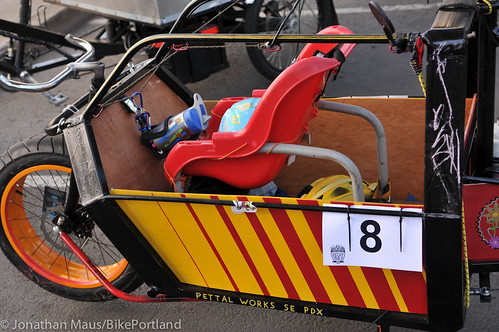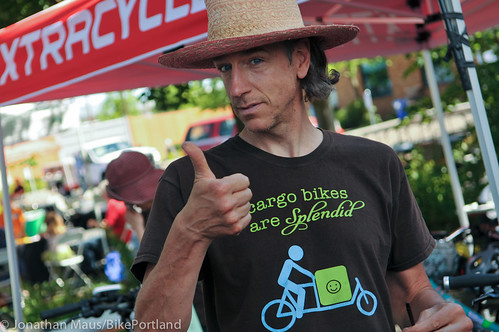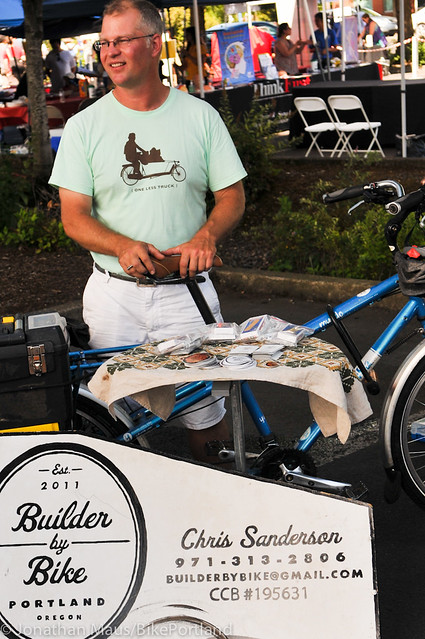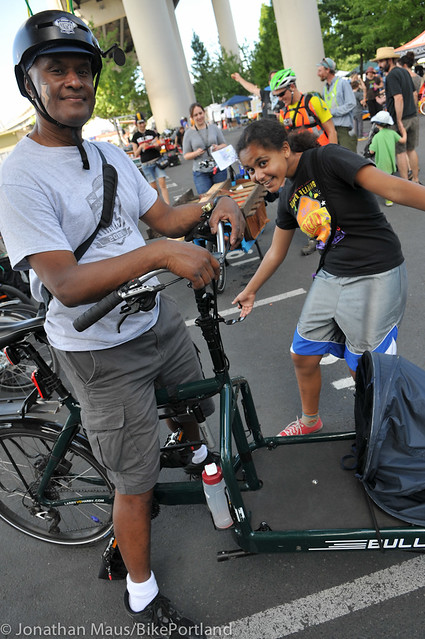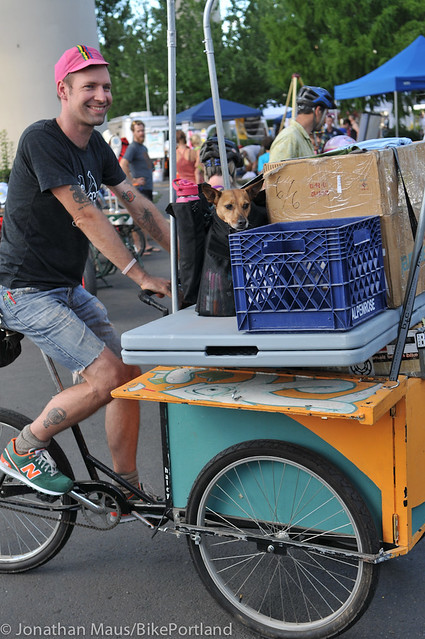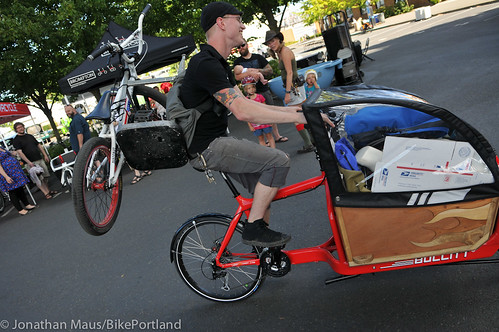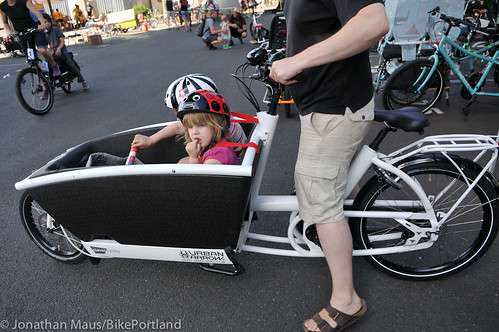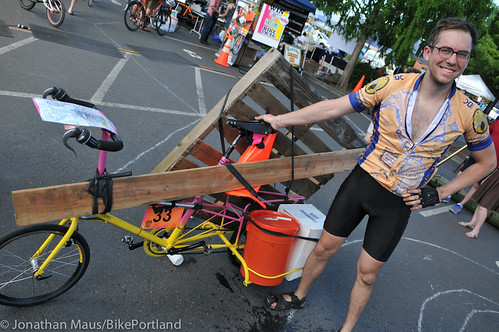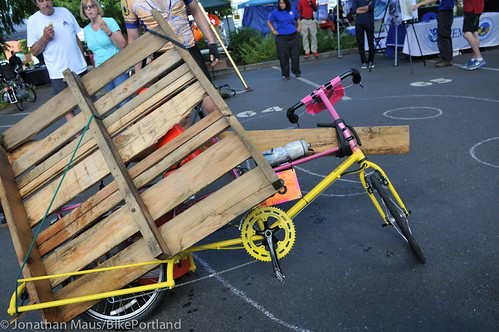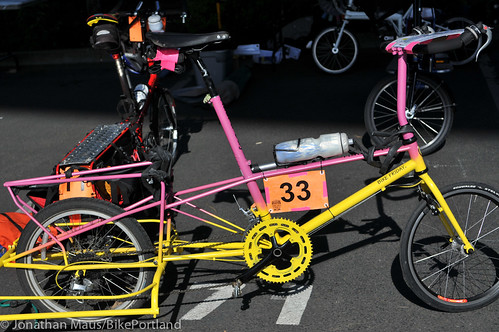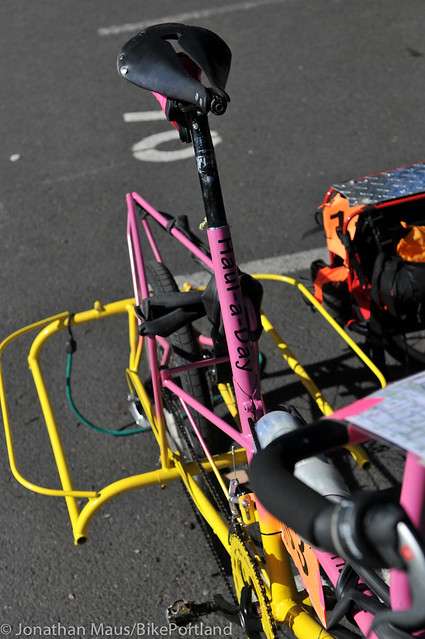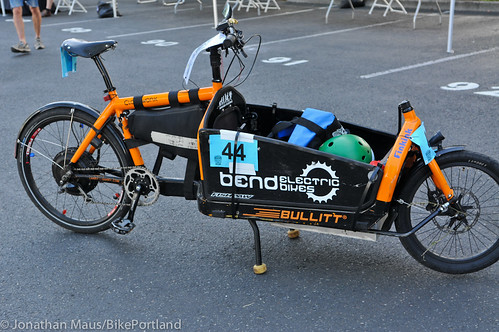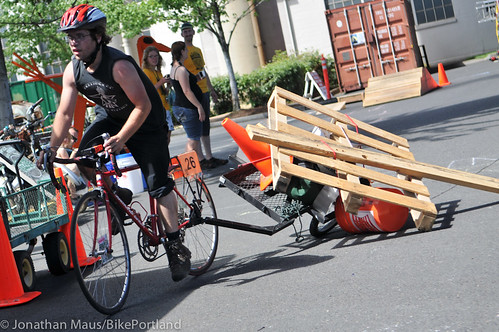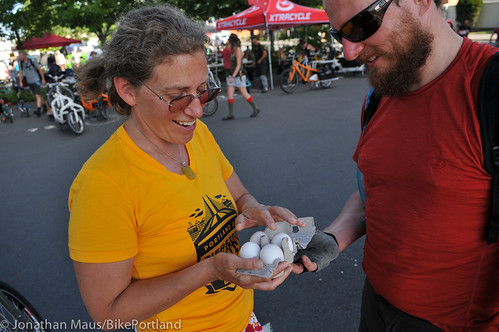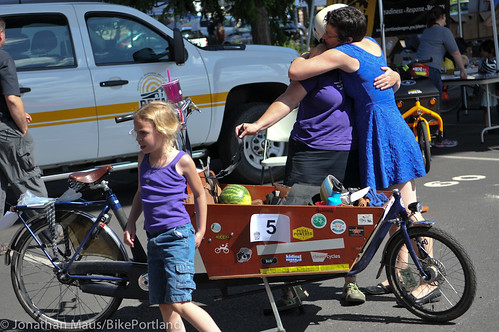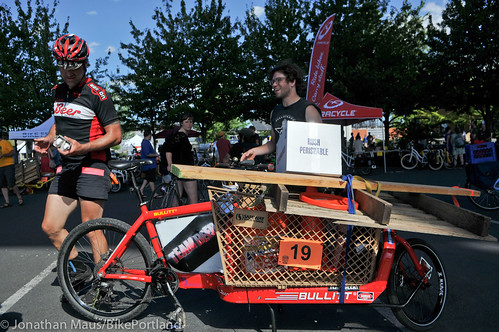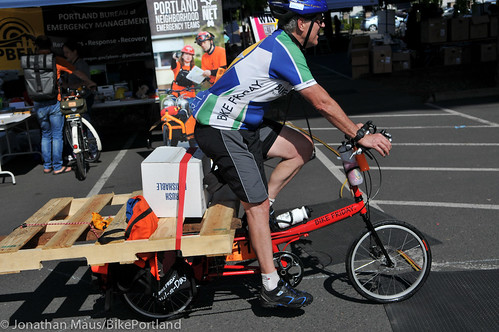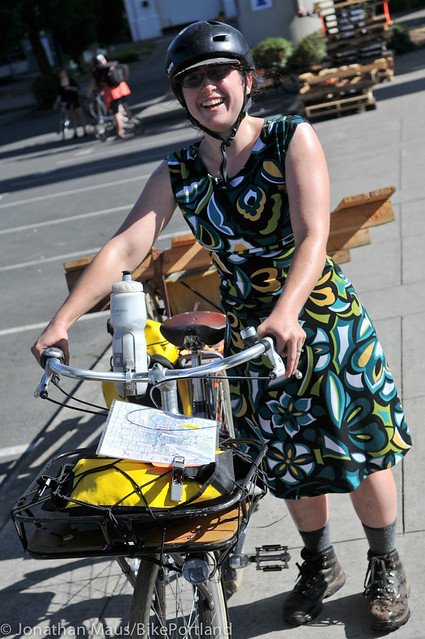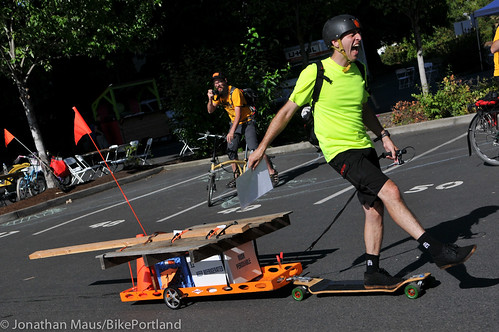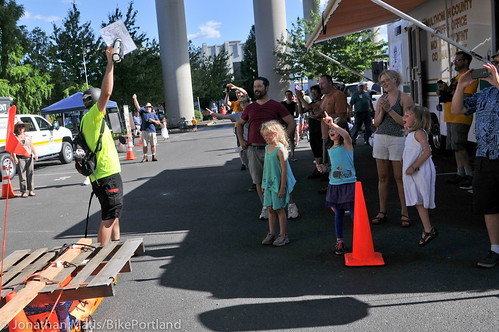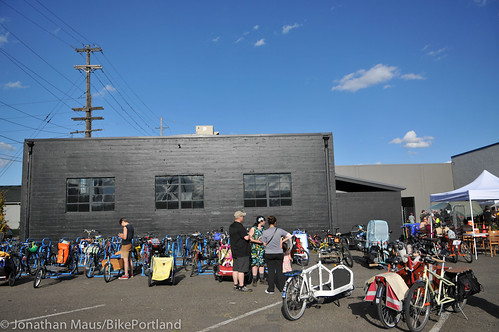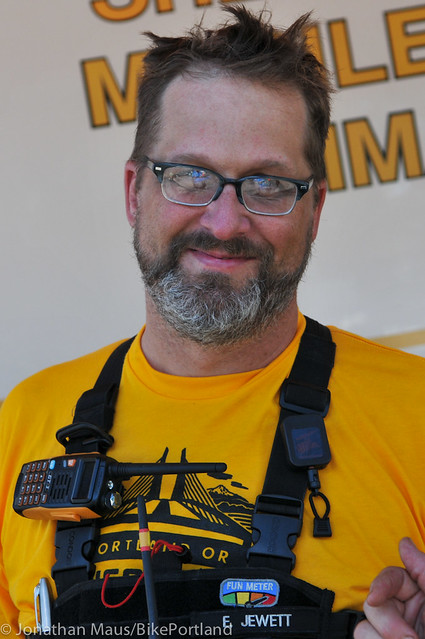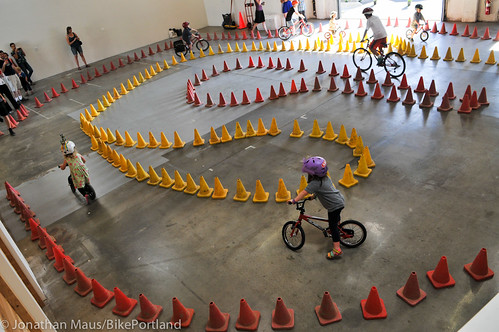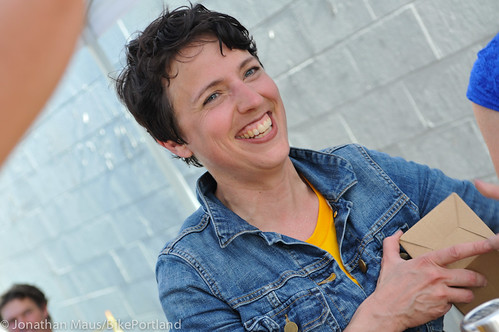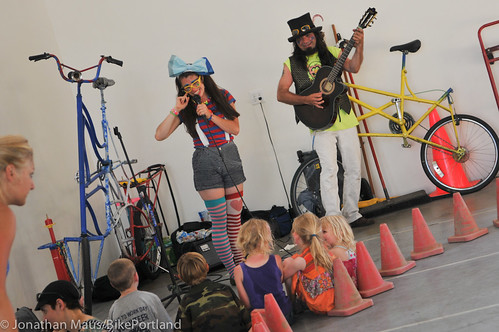
(Photos by Jonathan Maus/BikePortland)
“I help you, you help me!”
Those aren’t the words you expect to hear during a competitive cycling event. But when the event — the third annual Disaster Relief Trials — is based around a mock disaster and the competitors are piloting 150 pounds or more of bike and cargo on a challenging, 35-mile course, teamwork takes priority over individual gain.
Around 40 riders took part in the DRT on Saturday. There were three classes of riders: The “replenish” class was billed as family friendly and participants were required to carry one other person (most opted for a young child). The “open” and “e-bike” classes were more competitive and had to tackle a longer, more challenging course.
The premise was that riders were responding to a major disaster, such as an earthquake, where trains, buses, and cars will have been rendered useless. Roads and bridges will have crumbled. Gasoline might be gone or in very short supply. Bicycles — especially ones with carrying capacity — will be the last vehicles standing.
Prior to the start, each competitor was given a map and manifest. Their mission was to leave from home base (an emergency response command center set up in the parking lot of the Oregon Museum of Science and Industry) and successfully navigate a variety of checkpoints. Open and e-bike class riders went as far south as Sellwood Riverfront Park, east to Sewellcrest Park (SE 32nd and Lincoln) and north to University of Portland and the Oregon Food Bank (NE 33rd and Columbia).
The checkpoints were more than a test of cycling skills. They tested each riders’ agility, sense of direction, creativity, patience, and will.
Advertisement
After filling five-gallon buckets with water (weighing about 45 pounds) from the Willamette River near the west end of the Hawthorne Bridge, the riders rolled south to Sellwood Park. Then it was north to Sewellcrest Park where things got interesting. For the remainder of the ride, the competitors would have to deal with a full-size pallet attached to their bikes. This awkward item was a test of packing skills. Some placed it flat on the front of their bikes, others tilted it vertically and strapped it to the side.
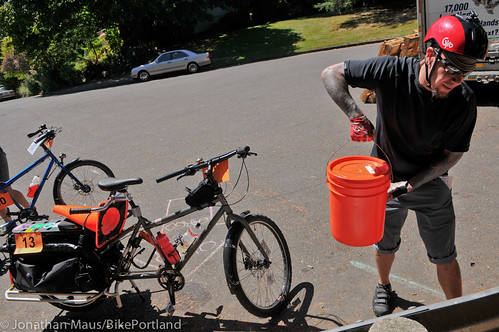
Once the pallet was strapped on, they had to lift it — and their bikes — over a three-foot railing. This created a bottleneck of riders at checkpoint 3 who barked instructions to each other in order to time their lifts. Once the bikes were over the obstacle, the riders hammered on their pedals to the next checkpoint — an industrial facility at N Cook and Mississippi.
This is where navigation proved invaluable. Several riders lost major time due to wrong turns and other navigation mistakes. Alexander Hongo and Lucas Strain came up from Eugene hoping to deliver an upset to the locals. But while riding north on Williams they missed the left turn on Fremont. By the time I saw them back at the finish line, Lucas said the mistake cost them several extra miles.
Here are some photos of the speedy riding between checkpoints 3 and 4…
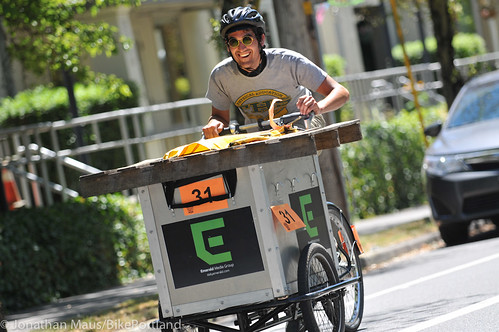
A few scenes from checkpoint 4…
By the time the riders reached the “Dirt” checkpoint on N Willamette Blvd, they had about 18 miles in their legs, a pallet, an eight-foot long 2 X 6 plank, and two full buckets of water on their bikes. And then it was time to tackle what many of them said was the hardest part of the entire course: a slippery singletrack trail and dirt hillclimb. The off-road section was hot and unforgiving on both riders and their bikes.
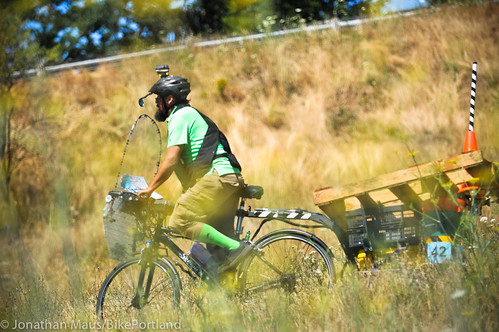
From there it was on to the last three checkpoints where the riders had to pull a victim in a sled behind their bikes, pick up a box of perishable food, and then take on four eggs — without breaking them — all the way back to the finish at OMSI.
While we waited at base camp for the riders to finish, the Cascadia Cargo Bike Fair was in full swing…

The first person to cross the line was Willy Hatfield with a time of three hours and eleven minutes. Hatfield is an engineer with Bike Friday and was riding a custom bike he designed specifically for the DRT (based loosely on the company’s “Haul-a-Day” model). Despite his unconventional bike and the fact that he admitted, “Nothing went to plan,” Hatfield got off to an early lead, chose good routes, and took home the victory.
In the e-bike class, Bend resident Sterling McCord finished first with a time of two hours and 25 minutes. The owner of Bend Electric Bikes, McCord rode a Bullitt “long John”-style cargo bike that he outfitted with an electric motor he assembled from secret parts.
Other finishers might not have been as fast, but this event isn’t about speed.
Tessa Walker rolled across several hours after the winners on her homemade, three-speed bike. “Amazing, ridiculous, awesome,” was how she described the experience to me. “The hardest part was when I realized it was just me, a pallet, and 40 pounds of water on some random street in Portland.”
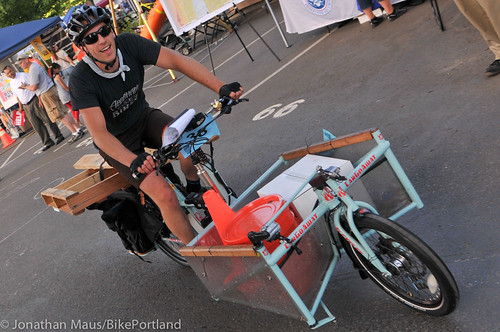
And then there was Cory Poole on a skateboard pulling a cargo trailer he built himself. It took him five hours and 11 minutes; but he got through every checkpoint and finished with the largest smile and the loudest ovation of the day.
Having proved the utilitarian prowess of cargo bikes, the organizers and riders attended a well-deserved afterparty at Islabikes in southeast Portland. The event featured an indoor bike track and entertainment from Dingo the Clown and Olive Rootbeer for the kids, and cold beverages for the adults.
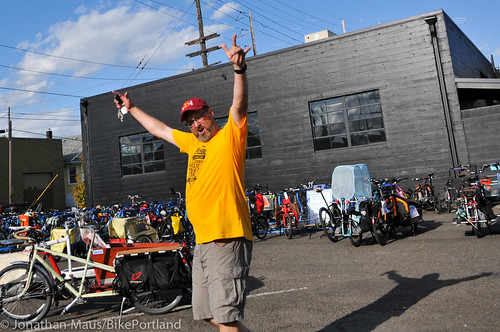
We’ve got lots more photos from the event over on Flickr. For more on the DRT, check out their website and follow them on Facebook.
